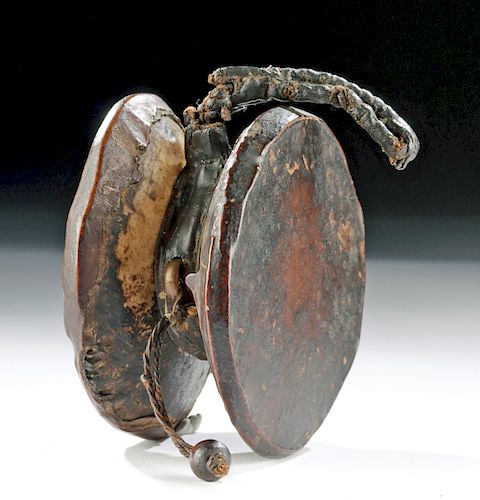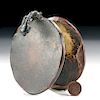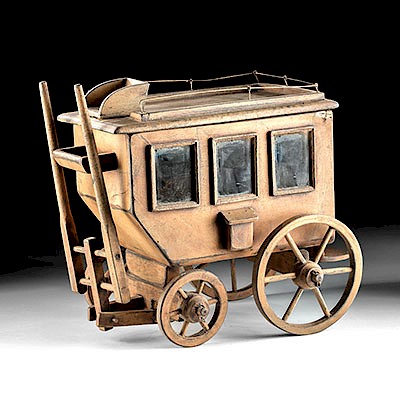Rare 16th C. Tibetan 2-Headed Drum / Damaru
Lot 201c
About Seller
Artemis Gallery
686 S Taylor Ave, Ste 106
Louisville, CO 80027
United States
Selling antiquities, ancient and ethnographic art online since 1993, Artemis Gallery specializes in Classical Antiquities (Egyptian, Greek, Roman, Near Eastern), Asian, Pre-Columbian, African / Tribal / Oceanographic art. Our extensive inventory includes pottery, stone, metal, wood, glass and textil...Read more
Categories
Estimate:
$3,500 - $5,000
Absentee vs Live bid
Two ways to bid:
- Leave a max absentee bid and the platform will bid on your behalf up to your maximum bid during the live auction.
- Bid live during the auction and your bids will be submitted real-time to the auctioneer.
Bid Increments
| Price | Bid Increment |
|---|---|
| $0 | $25 |
| $300 | $50 |
| $1,000 | $100 |
| $2,000 | $250 |
| $5,000 | $500 |
| $10,000 | $1,000 |
| $20,000 | $2,500 |
| $50,000 | $5,000 |
| $100,000 | $10,000 |
| $200,000 | $20,000 |
About Auction
By Artemis Gallery
Nov 14, 2019
Set Reminder
2019-11-14 10:00:00
2019-11-14 10:00:00
America/New_York
Bidsquare
Bidsquare : Ethnographic | Tribal | American Frontier
https://www.bidsquare.com/auctions/artemis-gallery/ethnographic-tribal-american-frontier-4634
Featuring Pre-Columbian, Tribal / Oceanic, Spanish Colonial, historical examples from the Spanish, Mexican, and American frontiers, fossils, and more. All items offered for sale have been legally acquired, are legal to sell and are guaranteed to be as described or your money back. Artemis Gallery info@artemisgallery.com
Featuring Pre-Columbian, Tribal / Oceanic, Spanish Colonial, historical examples from the Spanish, Mexican, and American frontiers, fossils, and more. All items offered for sale have been legally acquired, are legal to sell and are guaranteed to be as described or your money back. Artemis Gallery info@artemisgallery.com
- Lot Description
Central Asia, Tibet, ca. late 16th to 17th century CE. An early and rare example of a two-headed drum known as a damaru (damru), made from a pair of human skull caps that are fastened together in the middle with a brass ring. The central ring is covered with a thin cloth strip and protruding from one side is a braided animal skin handle. Each of the drumheads are covered with a stretched animal hide panel that is cured with copper, mineral salts, and herbal formulas. A petite beater bead on the end of a twisted fiber strand is attached to a central loop and is able to strike both drumheads. Many Tibetan instruments like this example were made with human skin, however animal hide is typically more readily available after a sky burial ceremony. Size: 3.4" W x 3.875" H (8.6 cm x 9.8 cm)
The damaru drum is used in both Tibetan Buddhism and Hinduism, and in the former it is used in tantric practices as just one of the sacred implements that form their rituals. Traditionally these items are made from a male and a female skull joined at their apex. Although we cannot see inside without destroying the skin; many are inscribed with mantras in gold. They are often played with the right hand, accompanied by a bell in the left hand.
Provenance: private Hawaii, USA collection; ex-private Schenne collection, New York, New York, USA
All items legal to buy/sell under U.S. Statute covering cultural patrimony Code 2600, CHAPTER 14, and are guaranteed to be as described or your money back.
A Certificate of Authenticity will accompany all winning bids.
We ship worldwide and handle all shipping in-house for your convenience.
#150872Loss to beater on one side. Minor tears to peripheries of leather drumheads and skin handle, and light staining to skull caps and leather components. Great patina throughout.Condition
- Shipping Info
-
All shipping is handled in-house for your convenience. Your invoice from Artemis Gallery will include shipping calculation instructions. If in doubt, please inquire BEFORE bidding for estimated shipping costs for individual items.
-
- Buyer's Premium



 EUR
EUR CAD
CAD AUD
AUD GBP
GBP MXN
MXN HKD
HKD CNY
CNY MYR
MYR SEK
SEK SGD
SGD CHF
CHF THB
THB














